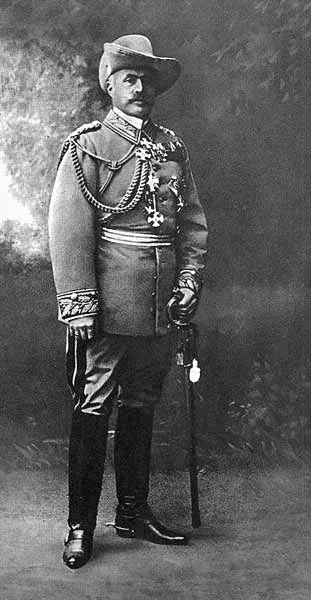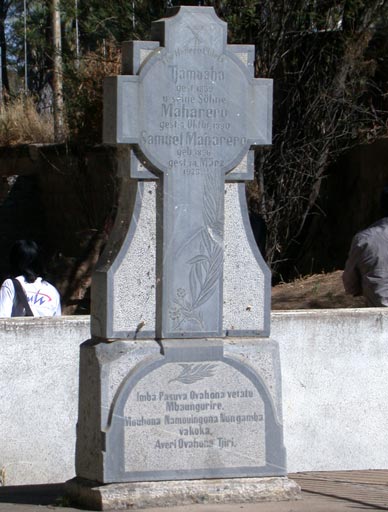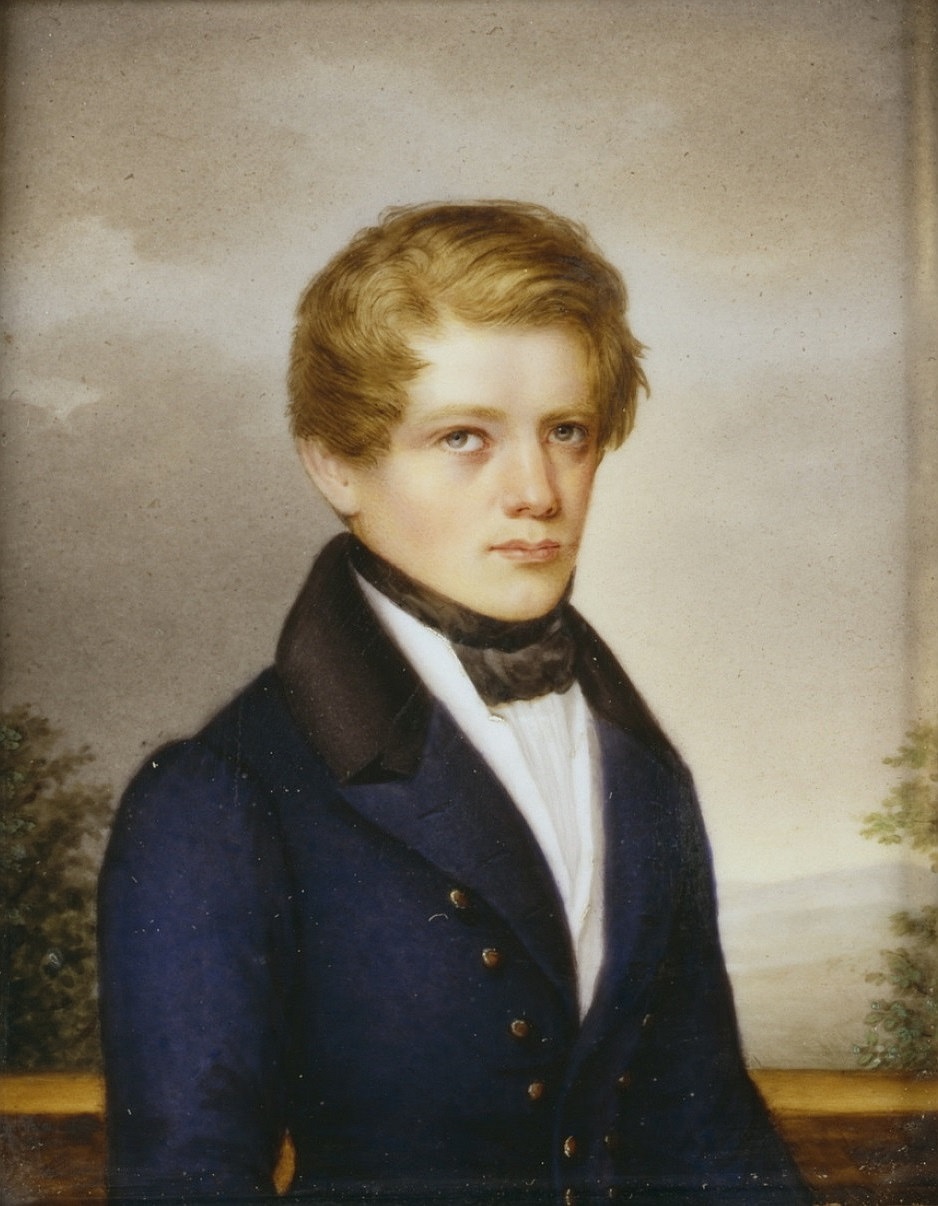|
Heinrich Ernst Göring
Heinrich Ernst Göring (31 October 1839 – 7 December 1913) was a German jurist and diplomat who served as colonial governor of German South West Africa. He was the father of five children including Hermann Göring, the Nazi leader and commander of the Luftwaffe (German Air Force). Personal life Göring was born in Emmerich am Rhein. He was the son of Wilhelm Göring (1791–1874), and his wife, Caroline Maria de Nerée (1815–1886). Göring married, secondly, to Franziska Tiefenbrunn: the marriage produced five recorded children: * Karl-Ernst Göring (born 1885 in Rosenheim; died 1932 in Hanover), jurist * Olga Therese Sophie Göring (born 1889 in Walvis Bay; died 1970) * Paula Elisabeth Rosa Göring (1890–1960) * Hermann Göring (born 1893 in Rosenheim; died 1946 in Nuremberg), German politician, military leader, and leading member of the Nazi Party (NSDAP) * Albert Göring (born 1895 in Friedenau, Berlin; died 1966 in Munich), businessman Career After a career as a ... [...More Info...] [...Related Items...] OR: [Wikipedia] [Google] [Baidu] |
List Of Colonial Governors Of South West Africa
This article lists the colonial governors of South West Africa. South West Africa was the colonial predecessor of the modern day Republic of Namibia from when the territory was controlled by the German Empire (as German South West Africa) and later by South Africa. The title of the position changed a number of times. Under German rule, the title of the position went from Commissioner (1884–1893) to Provincial Governor () (1893–1898) to Governor (1898–1915). Under South African rule, the title was Administrator (1915–1977) and Administrator-General (1977–1990). After the United Nations terminated South Africa's mandate to govern South West Africa, the UN appointed commissioners of its own. They had no authority and South Africa refused to recognize them, and are not included here. List * Dates in italics indicate ''de facto'' continuation of office German South West Africa South West Africa See also *United Nations Commissioner for Namibia *Namibia **Politics ... [...More Info...] [...Related Items...] OR: [Wikipedia] [Google] [Baidu] |
Luftwaffe
The ''Luftwaffe'' () was the aerial-warfare branch of the German ''Wehrmacht'' before and during World War II. Germany's military air arms during World War I, the ''Luftstreitkräfte'' of the Imperial Army and the '' Marine-Fliegerabteilung'' of the Imperial Navy, had been disbanded in May 1920 in accordance with the terms of the 1919 Treaty of Versailles which banned Germany from having any air force. During the interwar period, German pilots were trained secretly in violation of the treaty at Lipetsk Air Base in the Soviet Union. With the rise of the Nazi Party and the repudiation of the Versailles Treaty, the ''Luftwaffe''s existence was publicly acknowledged on 26 February 1935, just over two weeks before open defiance of the Versailles Treaty through German rearmament and conscription would be announced on 16 March. The Condor Legion, a ''Luftwaffe'' detachment sent to aid Nationalist forces in the Spanish Civil War, provided the force with a valuable testing grou ... [...More Info...] [...Related Items...] OR: [Wikipedia] [Google] [Baidu] |
Kaiser Wilhelm Institute Of Anthropology, Human Heredity, And Eugenics
The Kaiser Wilhelm Institute of Anthropology, Human Heredity, and Eugenics was founded in 1927 in Berlin, Germany. The Rockefeller Foundation partially funded the actual building of the Institute and helped keep the Institute afloat during the Great Depression. Eugenics In its early years, and during the Nazi era, it was strongly associated with theories of Nazi eugenics and racial hygiene advocated by its leading theorists Fritz Lenz, (first director) Eugen Fischer, and by its second director Otmar von Verschuer. In the years of 1937–1938, Fischer and his colleagues analysed 600 children in Nazi Germany descending from French-African soldiers who occupied western areas of Germany after First World War; the children, the so-called Rhineland Bastards, were subsequently subjected to sterilization. Fischer did not officially join the Nazi Party until 1940. However, he was influential with National Socialists early on. Adolf Hitler read his two-volume work, ''Principles of Hum ... [...More Info...] [...Related Items...] OR: [Wikipedia] [Google] [Baidu] |
Herero And Namaqua Genocide
The Herero and Namaqua genocide or the Herero and Nama genocide was a campaign of ethnic extermination and collective punishment waged by the German Empire against the Herero (Ovaherero) and the Nama in German South West Africa (now Namibia). It was the first genocide of the 20th century, occurring between 1904 and 1908. In January 1904, the Herero people, who were led by Samuel Maharero, and the Nama people, who were led by Captain Hendrik Witbooi, rebelled against German colonial rule. On January 12, they killed more than 100 German settlers in the area of Okahandja, although women, children, missionaries and non-German Europeans were spared. In August, German General Lothar von Trotha defeated the Ovaherero in the Battle of Waterberg and drove them into the desert of Omaheke, where most of them died of dehydration. In October, the Nama people also rebelled against the Germans, only to suffer a similar fate. Between 24,000 and 100,000 Hereros and 10,000 Nama died in the g ... [...More Info...] [...Related Items...] OR: [Wikipedia] [Google] [Baidu] |
Nama People
Nama (in older sources also called Namaqua) are an African ethnic group of South Africa, Namibia and Botswana. They traditionally speak the Nama language of the Khoe-Kwadi language family, although many Nama also speak Afrikaans. The Nama People (or Nama-Khoe people) are the largest group of the Khoikhoi people, most of whom have disappeared as a group, except for the Namas. Many of the Nama clans live in Central Namibia and the other smaller groups live in Namaqualand, which today straddles the Namibian border with South Africa. History For thousands of years, the Khoisan peoples of South Africa and southern Namibia maintained a nomadic life, the Khoikhoi as pastoralists and the San people as hunter-gatherers. The Nama are a Khoikhoi group. The Nama originally lived around the Orange River in southern Namibia and northern South Africa. The early colonialists referred to them as Hottentots. Their alternative historical name, "Namaqua", stems from the addition of the Khoekhoe ... [...More Info...] [...Related Items...] OR: [Wikipedia] [Google] [Baidu] |
Hendrik Witbooi (Namaqua Chief)
Hendrik Witbooi (c. 1830 – 29 October 1905) was a chief of the ǀKhowesin people, a sub-tribe of the Khoikhoi. He led the Nama people during their revolts against German colonial rule in present-day Namibia, in connection with the events surrounding the Herero and Namaqua Genocide. He was killed in action on 29 October 1905. Witbooi is regarded as one of the national heroes of Namibia, and his face is portrayed on the obverse of all N$50, N$100 and N$200 Namibian dollar banknotes. Names Kaptein Hendrik Witbooi (also spelt Witboi) was also known by the Nama name and the nickname ''Kort'' (from Dutch kort = short), in Herero ''Korota'' or pejorative ''Otjikorota''. Family and early life The family of Hendrik Witbooi made its mark as important members of Nama tribes. His grandfather, David Witbooi, was Chief of the tribe, who led the tribe across the Orange River into Namaland. His father, Moses Witbooi, was also a Chief of the tribe. His uncle, Jonker Afrikaner, was al ... [...More Info...] [...Related Items...] OR: [Wikipedia] [Google] [Baidu] |
Maharero
Maharero kaTjamuaha (Otjiherero: ''Maharero, son of Tjamuaha'', short: Maharero; 1820 – 7 October 1890) was one of the most powerful paramount chiefs of the Herero people in South-West Africa, today's Namibia. Early life Maharero, was born about 1820 at Okahandja. In 1843 he went with his father Tjamuaha to Windhoek to stay with Jonker Afrikaner, Captain of the Oorlam Afrikaners. Tjamuaha was an ally of Jonker Afrikaner until his death in 1861, albeit in a subordinate position. Maharero a leader of Ovaherero community in (1861-1890) was born in ca 1820 at Otjikune near Okahandja and he was the son of Tjamuaha and his chief wife Tjorozumo. He had several brothers and half-brothers, amongst them were Kavezeri, Kariteova, Kavikunua and Rijarua. Like his father, Maharero became an ally of Jonker Afrikaner in 1843. As from 1863 onwards, he refused to accept the dominance of the Afrikaners and was recognized by both Herero’s and the European in the country as the representat ... [...More Info...] [...Related Items...] OR: [Wikipedia] [Google] [Baidu] |
Herero People
The Herero ( hz, Ovaherero) are a Bantu ethnic group inhabiting parts of Southern Africa. There were an estimated 250,000 Herero people in Namibia in 2013. They speak Otjiherero, a Bantu language. Though the Herero primarily reside in Namibia, there are also significant populations in Botswana and Angola. In Botswana, the Hereros or Ovaherero are mostly found in Maun and some villages surrounding Maun. These villages among others are Sepopa, Toromuja, Karee and Etsha. Some of them are at Mahalapye. In the South eastern part of Botswana they are at Pilane. There are also a few of them in the Kgalagadi South, that is Tsabong, Omawaneni, Draaihoek and Makopong Villages. Overview Unlike most Bantu, who are primarily subsistence farmers,Immaculate N. Kizza, ''The Oral Tradition of the Baganda of Uganda: A Study and Anthology of Legends, Myths, Epigrams and Folktales'' p. 21: "The Bantu were, and still are, primarily subsistence farmers who would settle in areas, clear land, or ... [...More Info...] [...Related Items...] OR: [Wikipedia] [Google] [Baidu] |
German South West Africa
German South West Africa (german: Deutsch-Südwestafrika) was a colony of the German Empire from 1884 until 1915, though Germany did not officially recognise its loss of this territory until the 1919 Treaty of Versailles. With a total area of 835,100 km², it was one and a half times the size of the mainland German Empire in Europe at the time. The colony had a population of around 2,600 Germans. German rule over this territory was punctuated by numerous rebellions by its native African peoples, which culminated in a campaign of German reprisals from 1904 to 1908 known as the Herero and Namaqua genocide. In 1915, during World War I, German South West Africa was invaded by the Western Allies in the form of South African and British forces. After the war its administration was taken over by the Union of South Africa (part of the British Empire) and the territory was administered as South West Africa under a League of Nations mandate. It became independent as Namibia on 21 ... [...More Info...] [...Related Items...] OR: [Wikipedia] [Google] [Baidu] |
Otto Von Bismarck
Otto, Prince of Bismarck, Count of Bismarck-Schönhausen, Duke of Lauenburg (, ; 1 April 1815 – 30 July 1898), born Otto Eduard Leopold von Bismarck, was a conservative German statesman and diplomat. From his origins in the upper class of Junker landowners, Bismarck rose rapidly in Prussian politics, and from 1862 to 1890 he was the Minister President of Prussia, minister president and List of foreign ministers of Prussia, foreign minister of Prussia. Before his rise to the Executive (government), executive, he was the Prussian ambassador to Russian Empire, Russia and Second French Empire, France and served in both houses of the Landtag of Prussia, Prussian Parliament. He masterminded the unification of Germany in 1871 and served as the first Chancellor of Germany#Under the Emperor (1871–1918), Chancellor of the German Empire until 1890, in which capacity he dominated European affairs. He had served as the chancellor of the North German Confederation from 1867 to 1871, alon ... [...More Info...] [...Related Items...] OR: [Wikipedia] [Google] [Baidu] |
Friedenau
Friedenau () is a locality (''Ortsteil'') within the borough (''Bezirk'') of Tempelhof-Schöneberg in Berlin, Germany. Relatively small by area, its population density is the highest in the city. Geography Friedenau is part of the southwestern suburbs, right at the border with the inner city Schöneberg district, separated by the Berlin Ringbahn and the BAB 100 motorway (''Stadtring''). It borders the Wilmersdorf locality to the west and Steglitz to the south. The streets and squares are laid out according to a geometric urban design with an almost complete assembly of ''Gründerzeit'' buildings, which survived the bombing of Berlin in World War II. Urban planning The characteristic feature of Friedenau its Carstenn layout, named after urban developer Johann Anton Wilhelm von Carsten. This symmetrical layout consists of an avenue dividing a circular road, which is demarcated by four town squares. Some streets in Friedenau were named after rivers in Alsace-Lorraine to commemo ... [...More Info...] [...Related Items...] OR: [Wikipedia] [Google] [Baidu] |
Nuremberg
Nuremberg ( ; german: link=no, Nürnberg ; in the local East Franconian dialect: ''Nämberch'' ) is the second-largest city of the German state of Bavaria after its capital Munich, and its 518,370 (2019) inhabitants make it the 14th-largest city in Germany. On the Pegnitz River (from its confluence with the Rednitz in Fürth onwards: Regnitz, a tributary of the River Main) and the Rhine–Main–Danube Canal, it lies in the Bavarian administrative region of Middle Franconia, and is the largest city and the unofficial capital of Franconia. Nuremberg forms with the neighbouring cities of Fürth, Erlangen and Schwabach a continuous conurbation with a total population of 800,376 (2019), which is the heart of the urban area region with around 1.4 million inhabitants, while the larger Nuremberg Metropolitan Region has approximately 3.6 million inhabitants. The city lies about north of Munich. It is the largest city in the East Franconian dialect area (colloquially: "F ... [...More Info...] [...Related Items...] OR: [Wikipedia] [Google] [Baidu] |








